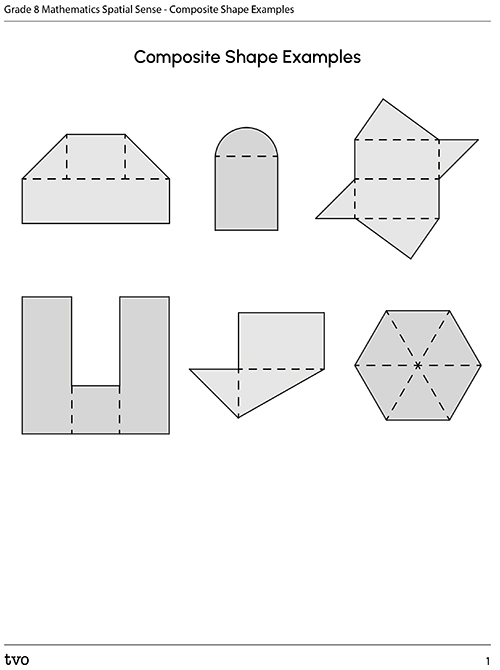Minds On
Calculating perimeter and area
Examine each shape and formula to review how to calculate the perimeter and area of the rectangle, triangle, parallelogram, and trapezoid.
Select the correct answer, then press 'Check Answer' to see how you did.
Review the following worksheet on perimeter and area formulas for different shapes.
Record the Perimeter and Area Formula Sheet in your notebook or using the following printable document. You can also use a method of your choice.
Press the ‘Activity’ button to access Perimeter and Area Formula Sheet.
Explore
Let's explore the following shapes:
Enough information?
After exploring the shapes, consider:
- How would you calculate the perimeter and area for the shapes?
- Is there enough information?
If you would like, you can complete the next activity using TVO Mathify or a method of your choice. You can also use your notebook or the following fillable and printable document.
Press the ‘TVO Mathify' button to access this interactive whiteboard and the ‘Activity’ button for your note-taking document. You will need a TVO Mathify login to access this resource.
TVO Mathify (Opens in a new window) Activity (Open PDF in a new window)Press 'Let's check!' to access the Perimeter and Area Calculations for the activity Enough Information?

This is a chart containing details of the required information needed to calculate the perimeter and area for four shapes.
The first shape is a trapezoid with side lengths of 13 metres, top length of 16 metres, and base length of 26 metres. The perimeter calculation is 13 metres plus 16 metres plus 13 metres plus 26 metres, which equals to 68 metres. The area calculation is incomplete because the height is not included in the diagram.
The second shape is a parallelogram with a side length of 7 centimetres, a top length of 8 centimetres, and a height of 4 centimetres. The perimeter calculation is 2 times 7 centimetres plus 2 times 8 centimetres, which equals to 30 centimetres. The area calculation is 8 centimetres times 4 centimetres, which equals to 32 centimetres squared.
The third shape is a triangle with the side lengths 6.2 centimetres and 9.3 centimetres, a base of 8.7 centimetres, and a height of 5.4 centimetres. The perimeter calculation is 6.2 centimetres plus 8.7 centimetres plus 9.3 centimetres, which equals to 24.2 centimetres. The area calculation is one half multiplied by 8.7 centimetres times 5.4 centimetres. This is simplified to one half multiplied by 46.98 centimetres, which equals to 23.49 centimetres squared.
The fourth and last shape is a rectangle with side lengths of 12 centimetres and 7 centimetres. The perimeter calculation is 2 times 12 centimetres, plus 2 times centimetres, which is equal to 58 centimetres. The area calculation is 12 centimetres times 7 centimetres, which equals to 84 centimetres squared.
Action
Composite shapes
Composite shapes are figures created by combining common shapes. Composite shapes are made up of a combination of different sized triangles, rectangles or even semi-circles.
Let's explore a few examples.
Explore the Composite Shape Examples in your notebook or using the following fillable and printable document. You can also use a method of your choice.
Student Tips
Did you know?
To determine the area or perimeter of a composite shape, we can split the shape into different pieces, like common shapes, and then solve them separately.
Which shapes?
Now, let's explore a few more composite shapes.
If you would like, you can complete the next activity using TVO Mathify or a method of your choice. You can also use your notebook or the following fillable and printable document.
Press the ‘TVO Mathify' button to access this interactive whiteboard and the ‘Activity’ button for your note-taking document. You will need a TVO Mathify login to access this resource.
TVO Mathify (Opens in a new window) Activity (Open PDF in a new window)Perimeter and area of composite shapes

Now let's consider the perimeter and area of composite shapes with this next activity.
If you would like, you can complete the next series of word problems using TVO Mathify or a method of your choice. You can also use your notebook or the following fillable and printable document.

Press the ‘TVO Mathify' button to access this interactive whiteboard and the ‘Activity’ button for your note-taking document. You will need a TVO Mathify login to access this resource.
TVO Mathify (Opens in a new window) Activity (Open PDF in a new window)Press the question number to reveal the solutions to the Composite Shapes: Perimeter and Area Word Problems activity.
This composite shape is composed of a semi-circle and a rectangle.
Perimeter:
-
The formula to calculate the perimeter of Shape A is:
(since we are only counting three sides).
- The formula to calculate the perimeter of Shape B is half of the circumference, so .
Area:
- The formula to calculate the area of Shape A is
-
The formula to calculate the area of Shape B is
(since it is only half a circle).
This composite shape is composed of a triangle and a semi-circle.
Area:
-
The formula for calculating the area of Shape A would be:
(since it is only half a circle).
-
The formula for calculating the area of Shape B would be:
Total perimeter and area:
-
The formula for calculating the total perimeter would be:
- To find the total area, we can add the two areas together.
Consolidation
Designing with composite shapes
Let's examine the following design created with composite shapes and pattern blocks:

Creating a design
It's your turn to create a composite shape design.
You may wish to use tools like tangrams, pattern blocks, or small tiles to help create your design.
If you would like, you can complete the activity using TVO Mathify or a method of your choice. You can also use your notebook or the following fillable and printable document.
Press the ‘TVO Mathify' button to access this interactive whiteboard and the ‘Activity’ button for your note-taking document. You will need a TVO Mathify login to access this resource.
TVO Mathify (Opens in a new window) Activity (Open PDF in a new window)Reflection
As you read the following descriptions, select the one that best describes your current understanding of the learning in this activity. Press the corresponding button once you have made your choice.
I feel...
Now, expand on your ideas by recording your thoughts using a voice recorder, speech-to-text, or writing tool.
When you review your notes on this learning activity later, reflect on whether you would select a different description based on your further review of the material in this learning activity.
Connect with a TVO Mathify tutor
Think of TVO Mathify as your own personalized math coach, here to support your learning at home. Press ‘TVO Mathify’ to connect with an Ontario Certified Teacher math tutor of your choice. You will need a TVO Mathify login to access this resource.
TVO Mathify (Opens in a new window)



